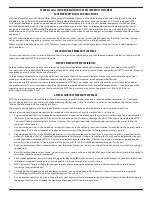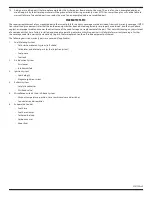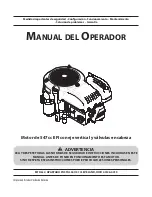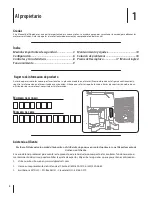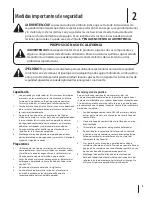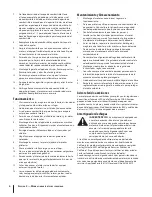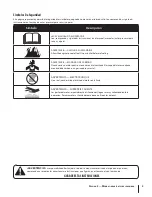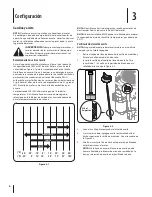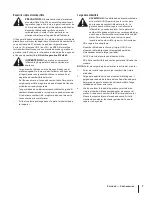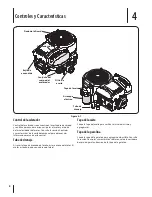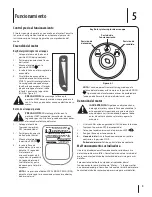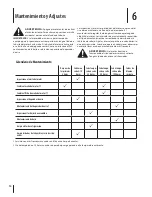
14
S
ection
6 — M
aintenance
3.
Measure the plug gap with a feeler gauge. Correct as
necessary by bending electrode. See Figure 6-10. The gap
should be set to 0.024-0.031 in.
Electrode
0.024-0.031 in.
Figure 6-10
4.
Check that the spark plug washer is in good condition
and thread the spark plug in by hand to prevent cross-
threading.
5.
After the spark plug is seated, tighten with a spark plug
wrench to compress the washer.
NOTE:
When installing a new spark plug, tighten 1/2 turn
after the spark plug seats to compress the washer. When
reinstalling a used spark plug, tighten 1/8-1/4 turn after the
spark plug seats to compress the washer.
IMPORTANT:
The spark plug must be securely tightened.
An improperly tightened spark plug can become very hot
and may damage the engine.
Fuel Filter Service
NOTE:
The fuel filter does not require service and is not
replaceable.
WARNING:
Fuel system under pressure. Do not
modify, remove, or tamper with any part or
component of the fuel system. Fuel system
includes: fuel tank, fuel lines, fuel fittings, and
throttle body assemblies.
WARNING:
Use extreme care when handling
gasoline. Gasoline is extremely flammable and the
vapors are explosive.
Clean Engine
If the engine has been running, allow it to cool for at least half
an hour before cleaning. Periodically remove dirt build-up from
engine. Clean cooling fins every 25 hours. Clean with a brush or
compressed air.
IMPORTANT:
Do not spray engine with water to clean because
water could contaminate fuel. Using a garden hose or pressure
washing equipment can also force water into the air cleaner or
muffler opening. Water in the air cleaner will soak the paper
element, and water that passes through the element or muffler
can enter the cylinder, causing damage.
WARNING:
Accumulation of debris around muffler
could cause a fire. Inspect and clean before every
use.
Storage
CAUTION:
Failure to use a fuel stabilizing additive
before off-season storage may result in damage to
your engine’s carburetor. Subsequent damage
would
not
be covered under the manufacturer’s
warranty.
Gasoline that will be stored longer than 30 days needs to be
pre-treated upon purchase with fuel stabilizer to prevent
gum and varnish from forming in the engines fuel and intake
system. Improper fuel storage can result in hard starting, no
starting, stalling and poor performance. If the gasoline in your
engine deteriorates during storage, you may need to have the
carburetor, and other fuel system components, serviced or
replaced.
1.
The fuel tank should be at least 95% filled with fuel. A full
fuel tank reduces condensation build up.
WARNING:
Never leave engine unattended while
running.
2.
Change oil. See Oil Change section.
3.
Remove spark plug and pour about 1/2 an ounce of engine
oil into cylinder. Replace spark plug and crank slowly to
distribute oil.
4.
Clean debris from around engine, under finger guard, and
under, around and behind muffler. Touch up any damaged
paint, and coat other areas that may rust with a light film
of oil.
5.
Store in a clean, dry and well ventilated area away from any
appliance that operates with a flame or pilot light, such
as a furnace, water heater, or clothes dryer. Also avoid any
area with a spark producing electric motor, or where power
tools are operated.
6.
If possible, also avoid storage areas with high humidity,
because that promotes rust and corrosion.
7.
Keep the engine level in storage. Tilting can cause fuel or
oil leakage.
Removing From Storage
1.
Check your engine as described in the Pre-Operation Check
section of this manual. Check for debris under blower
housing.
2.
If the fuel was drained during storage preparation, fill the
tank with fresh gasoline. If you keep a container of gasoline
for refueling, make certain it contains only fresh fuel.
Gasoline oxidizes and deteriorates over time, causing hard
starting.
3.
If the cylinder was coated with oil during storage
preparation, the engine will smoke briefly at startup. This
is normal.

















